Copaxa flavobrunnea
|
|
Updated as per Bernhard Wenczel communication September 12, 2006
Updated as per personal communication with Reinhard Foerster, April 2007, December 2, 2008
Updated as per personal communication with Kirby Wolfe, April 20, 2007
Updated as per Nachr. entomol. Ver. Apollo, N.F. 26 (1/2): 31-33 (2005) courtesy K. Wolfe, May 4, 2007
Updated as per personal communication with Carlos Mielke (Parana), April 2008
Updated as per personal communication with Fernando Penco (San Pedro City, Misiones), May 2008
Updated as per personal communication with Enio Branco (Tapirai, Sao Paulo, Brazil, October, 2014), February 2016
Updated as per personal communication with Marcello Massari (Juquitiba, Sao Paulo, Brazil, October, 2014), February 2016
|
Copaxa flavobrunnea
koh-PACKS-uhMflagh-voh-BROON-nee-uh
Bouvier, 1930
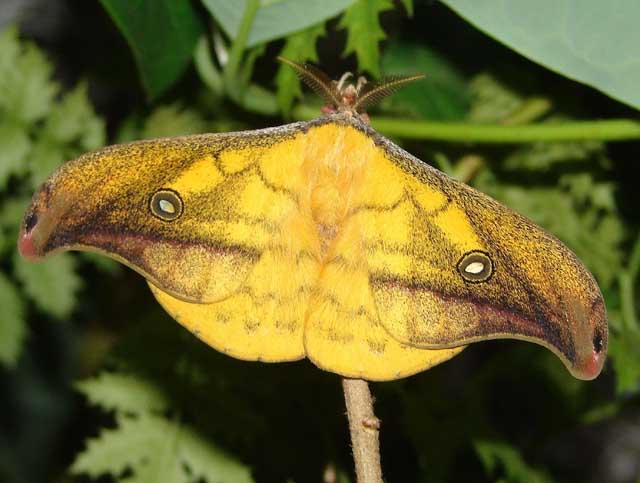
Copaxa flavobrunnea male
courtesy of Bernhard Wenczel.
This site has been created by
Bill Oehlke at oehlkew@islandtelecom.com
Comments, suggestions and/or additional information are welcomed by Bill.
| TAXONOMY:
Superfamily: Bombycoidea, Latreille, 1802
Family: Saturniidae, Boisduval, [1837] 1834
Subfamily: Saturniinae, Boisduval, [1837] 1834
Tribe: Saturniini, Boisduval, 1837
Genus: Copaxa, Walker, 1855
| | MIDI MUSIC
"What.A.Wonderful.World"
copyright C. Odenkirk
MID
I CITY
ON.OFF
<bgsound src="world.mid" LOOP=FOREVER>
|
DISTRIBUTION:
Copaxa flavobrunnea
(Approximate ?? wingspan: males: 85-105mm; females: 105-120mm) flies
in
eastern Brazil: Bahia (??), Sao Paulo: Tapirai (EB); Juquitiba (MM), Parana (CM),
Santa Catarina (KW), and it is now recognized as having a more extensive range as Reinhard Foerster reports it from
Argentina: Misiones, with images confirmed by
Kirby Wolfe and Carlos Mielke.

Copaxa flavobrunnea male, San Pedro City, RN Nš14, Misiones, Argentina,
courtesy of Fernando Penco.
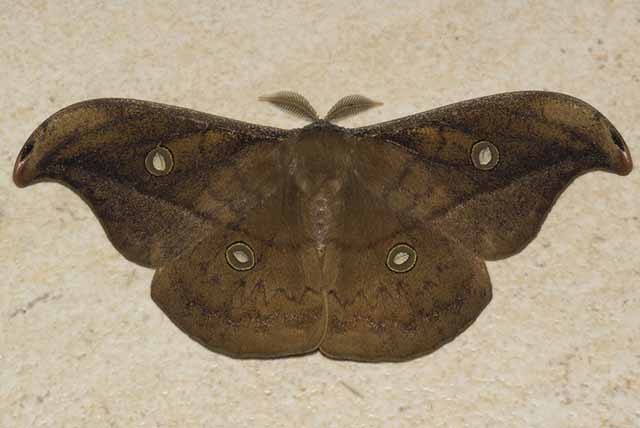
Copaxa flavobrunnaea male, Tapirai, Sao Paulo, Brazil,
October 1, 2014, courtesy of Enio Branco.
The male's forewings are quite falcate with a produced apex, more acute than canella, but not as pointed as joinvillea.
The males can be extremely variable in their colouration, but the antennae rami of the diurnal Copaxa flavobrunnea
are always dark as compared to the pale rami of the closely related, but nocturnal Copaxa canella and Copaxa joinvillea.
Male Copaxa flavobrunnea can be 1) yellow with a very dark brown-grey-black postmedian area;
2) an almost uniform dark brown; 3) orange or 4) coppery with a dark postmedian area; 5) very dark with a yellow to coppery cell area.
Male Copaxa flavobrunnea are consistently smaller than nocturnal canella, which are consistently fawn coloured. The
forewing apex is considerably more acute in C. flavobrunnea as compared to C. canella, but of the three species C. joinvillea
has the most elongated and pointed apex.

Copaxa flavobrunnea male, Juquitiba, Sao Paulo, Brazil,
March 27, 2016, courtesy of Marcello Massari, id by Bill Oehlke.
Male Copaxa flavobrunnea are about the same size as the nocturnal joinvillea which, so far, are consistently
orange-coppery with dark scales on the forewing veins and are a consistent pinkish-grey in the postmedian area. This last character seems lacking in C. flavobrunnea.
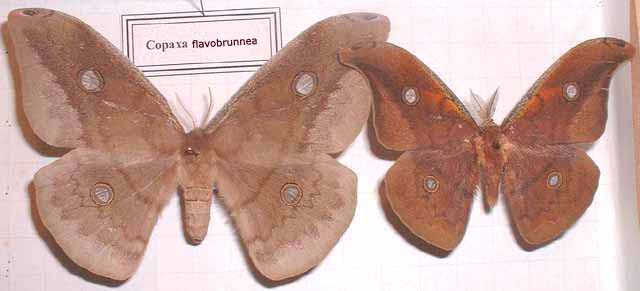
to Copaxa flavobrunnea
courtesy of Bernhard Wenczel.
Reinhard Foerster writes, "My breeding park or farm is located KM 43 Ruta 211 (near Dos de Mayo), Misiones, Argentina, 520 meter over the sea.
"I send a picture from male and female (normal color). The breeding occurs twice in the year. The first flight
begins in March and continues to this time, 15-April.The spring generation flies in September (southern hemisphere spring)."
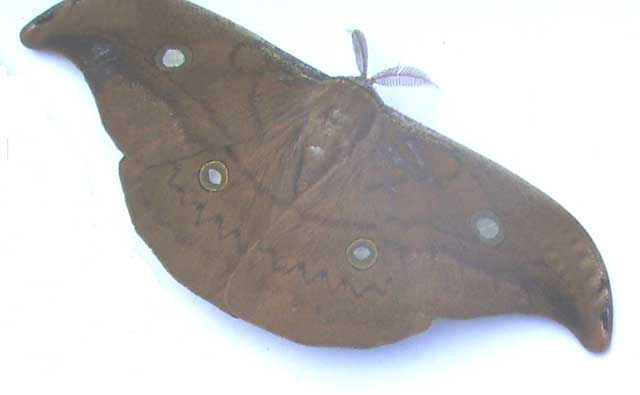
Copaxa flavobrunnea male, Misiones, Argentina, courtesy of
Reinhard Foerster,
id confirmed by Kirby Wolfe.
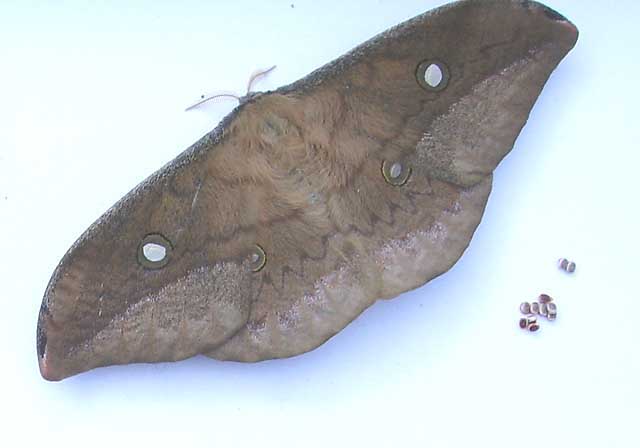
Copaxa flavobrunnea female, Misiones, Argentina, courtesy of
Reinhard Foerster,
id confirmed by Kirby Wolfe.
Reinhard reports these brown males report to grey females between 8:00 am and 10:00 am.
The cocoons of the above moth are of a very thin mesh. It is very easy to see the pupa and shed skin through the
weave of both the distinct inner and outer cocoons.
I believe this moth was originally described as a subspecies of
Copaxa canella, then synonymized with C. canella,
but it has recently been recognized as its own species according to
Stefan Naumann, Ulrich Brosch and Thibaud Decaens.
Kirby Wolfe presents full life history images of this moth
in the publication (2005) where he elevates it to full species status.
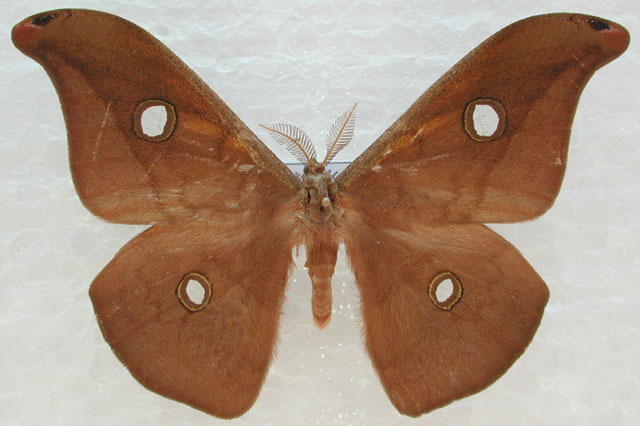
Copaxa flavobrunnea (male), Brazil, courtesy of
Eric van Schayck, id by
Carlos Mielke.
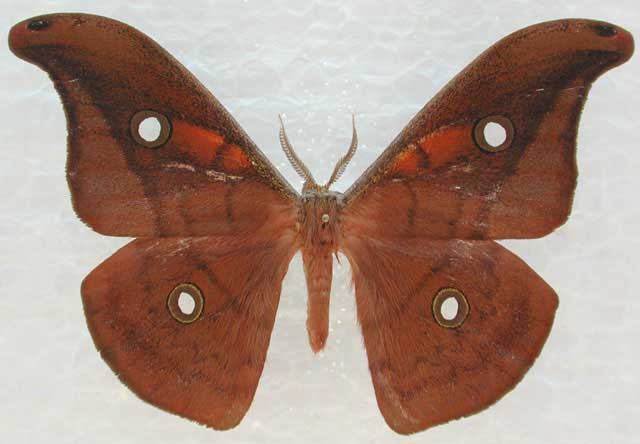
Copaxa flavobrunnea (male), Brazil, courtesy of
Eric van Schayck, id by Carlos Mielke.
FLIGHT TIMES AND PREFERRED FOOD PLANTS:
Copaxa
flavobrunnea larvae possibly feed upon laurel
(Phoebe porphyria).
Kirby Wolfe has reared them in the lab on Persea americana.
Most of the Copaxa brood continuously
so I suspect flavobrunnea would be on the wing every month of
the year. In Argentina Reinhard Foerster reports two flights: March til mid April and September (spring in Argentina).
Enio Branco reports an October flight in sao Paulo, Brazil.
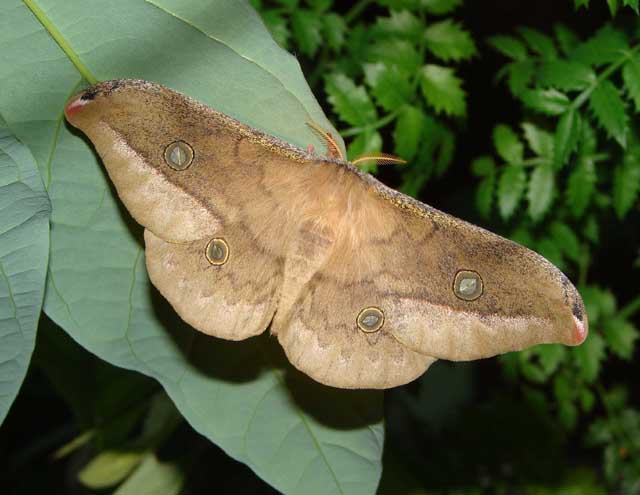
Copaxa flavobrunnea female
courtesy of Bernhard Wenczel.
ECLOSION, SCENTING AND MATING:
Male Copaxa flavobrunnea
moths use highly developed antennae to locate females
by tracking the airbourne pheromone plume. The female releases
this scent into the morning (8:00-10:00 am) air via an organ extended
from the tip of the abdomen.
Visit Copaxa flavobrunnea female, Parana, Brazil,
courtesy of Thibaud Decaens.
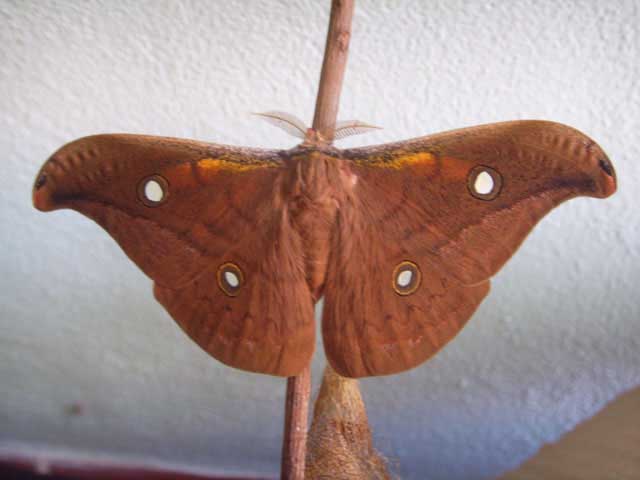
Copaxa flavobrunnea ?? brown male
??, Misiones,
Argentina,
courtesy of Reinhard Foerster.
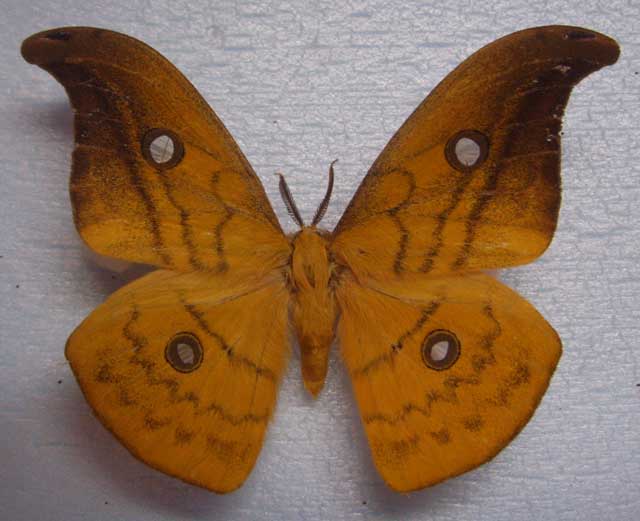
Copaxa flavobrunnea, yellow male, Dos de Mayo, Misiones, Argentina,
September 12, 2008, courtesy of Reinhard Foerster.
Kirby Wolfe notes that males of new world Saturniidae are usually
diurnal if the antennae ramni are dark as in flavobrunnea.
Females of all three species have pale antennae. Female canella
are larger, a consistent fawn colouration, and call at night.
Female flavobrunnea and joinvillea would be more difficult
to determine. Both females have a nocturnal flight, but flavobrunnea
call in the morning, while joinvillea call at night.
EGGS, LARVAE, COCOONS AND PUPAE:
Greyish-white eggs are rectangular with rounded edges. They are
girdled by a thin reddish-brown band and have a grey top.
When larvae reach the fourth instar, they demonstrate single, long,
dark hairs emanating from the scoli. The knobbed terminal ends
of these hairs are quite evident in the images below. They have not
proven to be urticating.
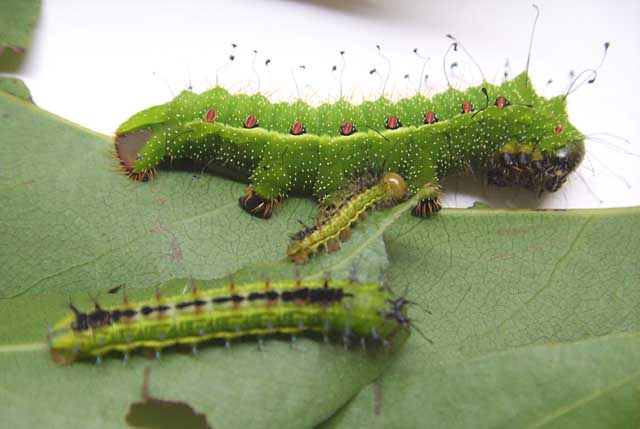
Copaxa flavobrunnea first, third, fifth instars, Misiones,
Argentina,
courtesy of Reinhard Foerster.
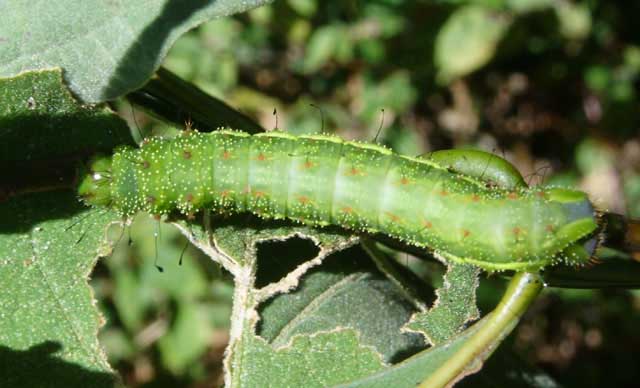
Copaxa flavobrunnea fifth instar, Misiones,
Argentina,
courtesy of Reinhard Foerster.
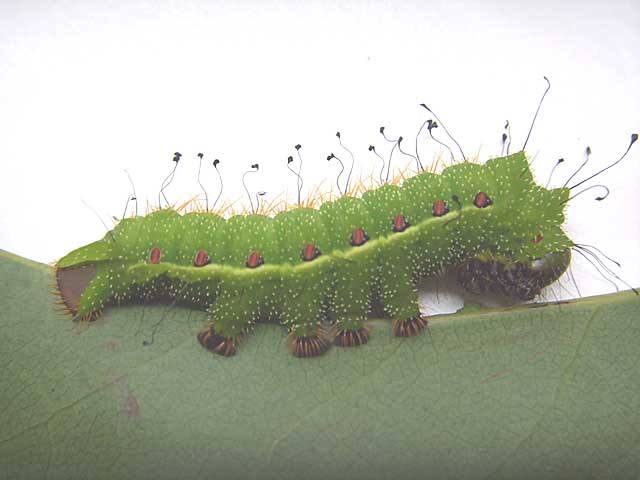
Copaxa flavobrunnea fifth instar, Misiones,
Argentina,
courtesy of Reinhard Foerster.
Kirby Wolfe indicates females tend to eclose two to three hours after dawn, but some emerge in the afternoon. Kirby also reports that
females emerge one to four months after pupation.
In my opinion (Bill Oehlke), it would seem this opens the propect of subsequent interbreeding on a generational level, ie, a male or female that remains dormant
for four months might pair with offspring of a sibling that has only been dormant for a month. Dirk Bayer has observed that some of his
early brood Callosamia securifera, a multi-brooded species in Alabama, go into a prolonged diapause (even overwinter) while siblings
progress through one or two more broods before diapausing.
It is hoped that this alphabetical listing followed by the common name of the (possible) foodplant will
prove useful. The list is not exhaustive. Experimenting with closely related foodplants is worthwhile.
Laurus nobilis
Nectandra reticulata.......
Nectandra venulosa
Persea americana
Phoebe porphyria
|
Bay Laurel
Nectandra reticulata
Nectandra venulosa
Avocado
Laurel
|
Return to Copaxa Index
Return to Main Saturniidae Index














